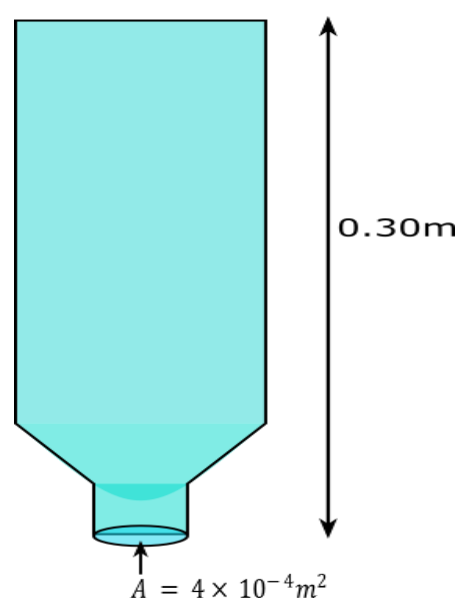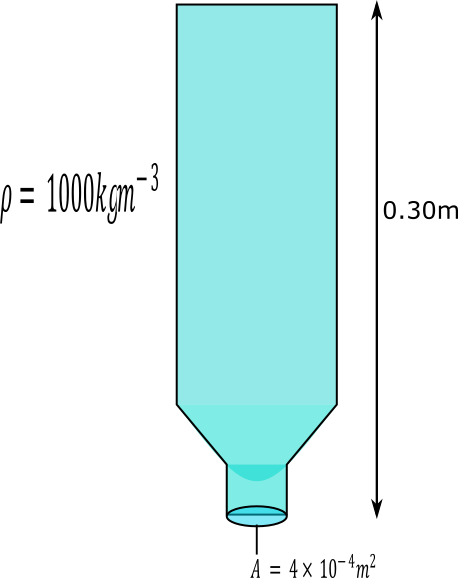
A bottle is filled with water. A cap is put on the bottle and it is turned upside down there is no air inside the bottle. The area of the cap in contact with water is $4.0 \times {10^{ - 4}}{m^2}$. The density of water is $1000kg{m^{ - 3}}$ and the gravitational field strength is $10Nk{g^{ - 1}}$. The water produces a force on the cap. What is the value of this force?

A) $0.075N$
B) $0.12N$
C) $1.2N$
D) $13N$
Answer
220.8k+ views
Hint:We can solve this question in simple two steps. First we calculate the pressure on the bottle cap due to liquid and after that we know the definition of pressure. Pressure is the perpendicular force per unit area. By this we can calculate the force on the cap.
Complete step by step solution:
Step 1: We know pressure on a point inside a liquid due to the liquid column is given by ${P_l} = \rho gh$.
Where $\rho \Rightarrow $ density of liquid
And $h \Rightarrow $ height of liquid column or depth of point from free surface
$g \Rightarrow $ Gravitational field strength $10Nk{g^{ - 1}}$ given in question.

From figure we can see the height cap from free surface is $0.30m$
So pressure on the cap of the bottle.
$ \Rightarrow {P_l} = \rho gh$
Put all values from above equation
$ \Rightarrow {P_l} = 1000 \times 10 \times 0.30$
Solving it
$ \Rightarrow {P_l} = 3 \times {10^3}N/{m^2}$
We get the pressure on cap due to liquid column so the net pressure on cap given by
$P = {P_{atm}} + {P_l}$
Here ${P_{atm}} = 0$ because in question it is given that there is no air inside bottle so atmospheric pressure is zero
So pressure on cap is $P = 3 \times {10^3}N/{m^2}$
Step 2: Now we know from the definition of pressure that the pressure is defined as force per unit area
$P = \dfrac{F}{A}$
So we can write $F = P \times A$
Putting value of pressure and area of cap area of cap given in question \[A = 4 \times {10^{ - 4}}{m^2}\]
$ \Rightarrow F = 3 \times {10^3} \times 4.0 \times {10^{ - 4}}$
$ \Rightarrow F = 12 \times {10^{ - 1}}$
Can written as $F = 1.2N$
$\therefore $ Force on cap is $1.2N$
So option (C) is correct.
Note: We can solve these types of questions in this easy way. If in this question the bottle is open from upside then there must be atmospheric pressure then total pressure is the sum of pressure due to liquid and pressure due to atmosphere.
Complete step by step solution:
Step 1: We know pressure on a point inside a liquid due to the liquid column is given by ${P_l} = \rho gh$.
Where $\rho \Rightarrow $ density of liquid
And $h \Rightarrow $ height of liquid column or depth of point from free surface
$g \Rightarrow $ Gravitational field strength $10Nk{g^{ - 1}}$ given in question.

From figure we can see the height cap from free surface is $0.30m$
So pressure on the cap of the bottle.
$ \Rightarrow {P_l} = \rho gh$
Put all values from above equation
$ \Rightarrow {P_l} = 1000 \times 10 \times 0.30$
Solving it
$ \Rightarrow {P_l} = 3 \times {10^3}N/{m^2}$
We get the pressure on cap due to liquid column so the net pressure on cap given by
$P = {P_{atm}} + {P_l}$
Here ${P_{atm}} = 0$ because in question it is given that there is no air inside bottle so atmospheric pressure is zero
So pressure on cap is $P = 3 \times {10^3}N/{m^2}$
Step 2: Now we know from the definition of pressure that the pressure is defined as force per unit area
$P = \dfrac{F}{A}$
So we can write $F = P \times A$
Putting value of pressure and area of cap area of cap given in question \[A = 4 \times {10^{ - 4}}{m^2}\]
$ \Rightarrow F = 3 \times {10^3} \times 4.0 \times {10^{ - 4}}$
$ \Rightarrow F = 12 \times {10^{ - 1}}$
Can written as $F = 1.2N$
$\therefore $ Force on cap is $1.2N$
So option (C) is correct.
Note: We can solve these types of questions in this easy way. If in this question the bottle is open from upside then there must be atmospheric pressure then total pressure is the sum of pressure due to liquid and pressure due to atmosphere.
Recently Updated Pages
Two discs which are rotating about their respective class 11 physics JEE_Main

A ladder rests against a frictionless vertical wall class 11 physics JEE_Main

Two simple pendulums of lengths 1 m and 16 m respectively class 11 physics JEE_Main

The slopes of isothermal and adiabatic curves are related class 11 physics JEE_Main

A trolly falling freely on an inclined plane as shown class 11 physics JEE_Main

The masses M1 and M2M2 M1 are released from rest Using class 11 physics JEE_Main

Trending doubts
JEE Main 2026: Application Form Open, Exam Dates, Syllabus, Eligibility & Question Papers

Derivation of Equation of Trajectory Explained for Students

Hybridisation in Chemistry – Concept, Types & Applications

Understanding the Angle of Deviation in a Prism

How to Convert a Galvanometer into an Ammeter or Voltmeter

Degree of Dissociation: Meaning, Formula, Calculation & Uses

Other Pages
Thermodynamics Class 11 Physics Chapter 11 CBSE Notes - 2025-26

JEE Advanced Marks vs Ranks 2025: Understanding Category-wise Qualifying Marks and Previous Year Cut-offs

Units And Measurements Class 11 Physics Chapter 1 CBSE Notes - 2025-26

NCERT Solutions For Class 11 Physics Chapter 8 Mechanical Properties Of Solids

Motion in a Straight Line Class 11 Physics Chapter 2 CBSE Notes - 2025-26

Laws of Motion Class 11 Physics Chapter 4 CBSE Notes - 2025-26




